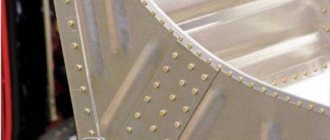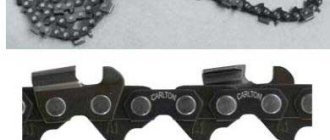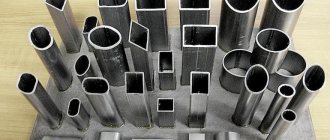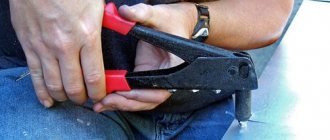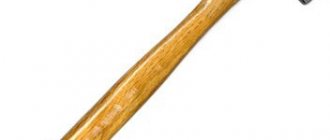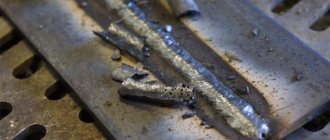A rivet is one of the most convenient and quickest fasteners to install, providing a reliable permanent connection. Today there is a huge variety of shapes and sizes of riveting fasteners, but hammer rivets were the first to be invented. They were used in the construction of ships, bridges and other metal engineering structures, where they successfully replaced welded joints. Today, this oldest type of fastener is made from modern materials, so it has not lost its popularity and has even expanded its scope of application.
Rivets. How to calculate the required rivet length
Author of the article:
If we turn to the history of the development of the technical side of civilization, we must admit that the rivet is one of the most ancient inventions of mankind. The first rivets found by archaeologists as part of bronze elements of armor date back to the year 500 BC, and the first written mention of a rivet discovered in Egypt is more than three thousand years old.
And this is logical. The rivet is easy to use and has a long enough service life to satisfy the needs of any craftsman, it is universal and applicable in almost any field of human activity. In addition, the riveting algorithm assumes the deformation of soft metal - and it was with the use of low-melting soft metals that progress began.
Over a long time, the rivet has undergone a lot of changes and received many new variations, which have made it possible to introduce this hardware into new areas and industries, ranging from construction and mechanical engineering, to unexpected areas of application, for example, in the confectionery or clothing industry. One of the most common types of rivets is a blind rivet. This is a convenient hardware, suitable for cases where access to the parts being fastened is only on one side.
Operating principle
Blind rivets consist of a sleeve, inside of which there is a rod with a seal at the end. In technical language, this seal is called a punch. During the riveting process, pressure is applied to the rod, causing the punch to deform the end of the rod into something like a head. At the same time, the sleeve itself also expands, fixing the attachment point.
Working with rivets is characterized by a relatively high speed, which can be considered an advantage of this hardware. Rivets are always treated with various compounds that are resistant to aggressive environments, high humidity and temperature changes, which increases their service life.
When length matters
Let us repeat, pointing out the importance of such a parameter as length. The correct formation of the closing head and the tightness of the connection depend on it. Excessive length here will be just as harmful as its lack. Against this background, the task of calculating the optimal length of connecting elements is important.
How to calculate the length. The formula is simple and therefore, before starting work, we recommend making these simple calculations, taking into account the following abbreviations:
S is the total thickness of the parts being connected;
d—diameter;
L is the required length.
Example: we have two parts with a thickness of 10 and 15 mm. The calculated diameter of the rivets is 4 mm. According to the formula: L = S+1.2d we have - 10+15+1.2*4 = 26.8 mm.
In this formula, “1.2” is a correction factor.
Its value depends on:
- head shape;
- material;
- heat treatment.
For domestic use, we calculate the length of the rivets using a coefficient of 1.2. In this case, it can be accepted as average and optimal.
Table 1 will help you choose the closest standard size for diameter 4. We get 30 mm.
The science of “Strength of Materials” recommends placing blind rivets (and others) at a distance of no closer than five diameters from each other. Let us add that there are special formulas for calculating fasteners for shearing and crushing of heads. Such calculations are made when designing quite important structures, and they are practically not used in everyday life.
Advantages and disadvantages
Like any product, aluminum rivets have a number of advantages, but also some disadvantages. Let's look at all positions in more detail. First, let's talk about the advantages. Users cite the plasticity of aluminum as one of the main advantages. This is very convenient, since fastening can be done quite quickly.
This characteristic allows us to add low energy consumption, as well as profitability. In addition, if the installation is carried out correctly, the strength of the connections will not be in doubt, and the work can be carried out even at home, without using special equipment.
Installation is quite easy and most often does not require the use of special tools. Aluminum is considered a fairly resistant material, so it withstands the effects of aggressive substances well and does not corrode. It is environmentally friendly, which can also be considered an undeniable advantage. At the same time, products made from it are very light.
As for the disadvantages, the following points should be noted. Undoubtedly, compared to copper or steel, aluminum is a less durable material. It should not be used if the structure is expected to be subject to strong and prolonged mechanical loads. You should also avoid using it if you plan to use aggressive materials. In this case, for example, an aluminum rivet can be used under conditions of negative environmental influences.
If materials are fastened using aluminum hardware, you should ensure that the insulation of the surfaces is done as carefully as possible. This will help the metals avoid contact with each other. In this case, it is best to use rubber or copper.
Types of blind rivets
The classification of blind rivets, as in the case of other hardware, is determined by the scope of their application, as well as the composition of the working material with which to deal. It is on these two factors that the understanding of how to make the right choice of a blind rivet when purchasing rests.
- Standard blind rivets. The principle of their operation was described above.
- Expansion rivets. It has an elongated sleeve that collapses when riveting, creating more material for fixation. This is very convenient if you need to fasten materials of different thicknesses and compositions.
- Reinforced blind rivets. They have a non-standard head shape, reminiscent of an arrowhead. This rivet provides a hermetically sealed connection with increased resistance to tension and lateral loads.
- Flap blind rivets. When riveting, the body of the hardware opens into petals that stick into the working surface, providing a large fixation area.
- Grooved blind rivets. Designed for blind holes. Applicable not only for metal, but also for wood.
- Closed blind rivets. They have a blind sleeve that envelops the head of the rod during operation, ensuring a completely tight connection.
- Multi-clamp blind rivets. The sleeve of such rivets is made of a softer metal than usual. The hardware is adjustable over a wide range, based on the thickness of the working material. The type of connection is aesthetic and pleasing to the eye.
Determining the length of a rivet with a closing head
To correctly install the rivet fastener, it is important to accurately select its length so that it is possible to create a closing head of the required shape from the protruding part of the rod and obtain a connection without gaps. The length of hammer rivets produced varies from 2 to 180 mm and is selected based on the thickness of the package of materials being fastened. First you need to determine the length of the protruding part of the rod (allowance). For the version with a semicircular head, the allowance is 1.2...1.5d, and for the version with a countersunk head - 0.8...1.2d, where d is the diameter of the rod. Based on the obtained allowance value, it is easy to calculate the total length of the rod by adding to it the thickness of the materials being riveted - S.
Pull and pull rivet
Sometimes in the description of a rivet you can find the name “traction”. It's still the same blind rivet without any changes. Apparently, the old name was preserved from those times when there was no unified tool for blind rivets. The rod was pulled out using improvised means, for example, pliers. This type of connection is sometimes used today, but it does not provide good fixation. It is recommended to use rivet guns, which are inexpensive and available in every hardware store.
How to use?
Using rivets is not too difficult - for cylindrical products you can even do without a special tool, just a regular hammer. You can work very successfully even in “field” conditions, not to mention in a full-fledged workshop. The largest steel rivets are used in the assembly of bridges and overpasses. Smaller products are in demand in mechanical engineering and instrument making
Important: riveted joints by default are not tight enough, and they can be sealed properly only by using sealants and special grades of rubber
A hole is usually pre-drilled. If a countersunk rivet is used, countersinking is recommended. The process for a blind rivet is something like this:
To learn how to make a steel rivet with your own hands, see the following video.
Types of fasteners
In nature, there are many types of fastening and the same variety of fastening elements.
We list the most popular of them:
- driving,
- exhaust threaded,
- exhaust smooth.
The classic and most ancient type of fastener is the driven-in type. The second and no less popular name is “under the hammer.” The material can be very different: aluminum, copper, steel. They consist of a cylindrical rod and a head (mostly, according to GOST 10299-80, this is a hemisphere). Semi-concealed, countersunk (GOST 10300-80) and cylindrical heads are also popular.
Important! The diameter of the rivets cannot be unlimited. Economic and technical feasibility determine their maximum length.
They are simple in shape, and simple auxiliary tools are used as installation assistants: a settler, a pretensioner and a hammer. In mass production, steel products are assembled with electric hammers or piston hammers.
When riveting by weight, you cannot do without reinforcement (anvil). During installation, a driven rivet requires compliance with tolerance standards for the diameter of the holes and the length of the rivet. Insufficient length will not allow the formation of an optimal head; excessive length will disrupt the tightness of the connection.
The design consists of two bushings connected at its head. The outer sleeve should be longer than the inner one and made of softer metal. The difference in the length of the bushings should be at least half the diameter of the hole in the parts being connected. In this area, a thread is cut, due to which the outer sleeve will be compressed and a second head will be formed.
Of all types of rivets, threaded rivets are the most expensive. However, the threaded rivet compensates for these shortcomings with quality, installation speed and neat appearance. The latter argument justifies their widespread use in the automotive industry and in the manufacture of various household appliances. The largest blind rivet has an internal thread M16, the smallest - M2.
Exhaust smooth is the most popular type of connection of parts for lightly loaded structures. Widely used in everyday life, in private farmsteads and in workshops. A worthy alternative to welding where there is a problem with electricity. The popularity of this type of fastener obliges us to dwell on them in more detail.
Description
These hardware are used to inextricably connect different materials. Before you start work, you need to make sure that this type of product is suitable for specific parts. In general, a rivet is a smooth cylindrical rod that has a factory head at one end. It is capable of connecting 2 or more elements. To do this, the product is installed in a specially prepared hole of slightly larger diameter than itself.
After the hardware is installed, its back part is flattened with a special tool or an ordinary hammer. As a result of this, the rod becomes approximately 1.5 times thicker, in addition, a second head appears. Aluminum rivets are predominantly painted at the production stage. Most often they come in black.
They are readily used in the construction of ships and aircraft, in the cosmetic and food industries, and are also successfully used in chemical production. This is explained by the huge number of positive properties that the manufacturing material has.
Application
The variety of areas for using blind rivets, as already mentioned, tends to infinity. But it is still possible to identify the main industries in which this hardware has become traditional.
- Electronics and energy.
- Consumer goods of the widest profile. From complex mechanics to simple objects with a composite structure.
- Mechanical engineering.
- Construction, in the broadest sense, starting from the connection points of supporting structures and ending with interior decoration (including interior decoration).
How to choose a blind rivet?
Three factors influence the correct choice of these hardware.
- Firstly, this is the required strength of the connection. You need to understand how long a service life you need, what loads the structure will experience and what aggressive environmental influences the working surface is exposed to.
- Secondly, study the components and tools that are available. Some rivets can be used without a rivet gun, but, unfortunately, this does not apply to blind rivets.
- Third, you need to select blind rivets based on the feasibility of the planned purchase. The cost of hardware varies not only from brand to brand, but also depending on the material from which the hardware is made. It is not necessary to buy the most expensive ones - they are all produced in accordance with GOST and are designed for most known types of work.
Advantages and disadvantages
The high consumer demand for blind rivets is due to a number of undeniable advantages of these hardware.
- The ease of installation is due to the need to access the connection only from the front side. This distinguishes these hardware from threaded nuts, the installation of which requires access from both sides. In addition, threaded fasteners tend to unscrew over time and weaken the connection.
- The low cost of blind rivets allows you to create a reliable and durable fastening without saving on material.
- A wide range of standard sizes greatly facilitates the selection of fasteners.
- The ability to connect materials of different structure and properties significantly expands the scope of application of hardware.
- High strength and durability of the connection. If the installation rules and careful operation are followed, the service life of rivets is equal to, and sometimes even exceeds, the service life of the parts being fastened.
Disadvantages include the need for pre-drilling, the inseparability of the connection and the application of significant effort when riveting manually. In addition, the models are single-use and cannot be reused.
Threaded rivets and their types
Threaded rivets are often called nut rivets, internally threaded rivets, nut rivets or bolt rivets. Rivets of this type are a sleeve with an internal thread made approximately half the length and a small flange (side) necessary for reliable fastening of the rivet in the metal. Such rivets are made from various materials such as galvanized steel, stainless steel, aluminum alloys and EPDM rubber. In addition to the material, threaded rivets differ in the diameter of the thread, as well as the shape of the body and the type of flange.
Purpose
The purpose of nut rivets is to create a thread in metal whose thickness can be from 0.3 mm to 6.0 mm, for subsequent connection of parts using screws or bolts.
Installation of threaded (nut) rivets
To install threaded rivets correctly, a special tool called a thread riveter is used. The threaded rod of the riveter is screwed into the nut rivet and the rivet is placed in a pre-prepared hole in the base material. (The diameter of the hole depends on the size of the rivet and is determined from the catalog src=»https://krepmix.ru/upload/library/554/55455cc59e562b1862996d9fc4d5b627.png» class=»aligncenter» width=»672″ height=»457″[/img ]
Next, the threaded rod is pulled into the body of the rivet gun and the part of the rivet that does not have an internal thread is deformed, reliably fixing the rivet in the hole. (The length of the rivet is selected according to the manufacturer’s catalog depending on the thickness of the material in which it needs to be installed)
After installation, the threaded rod of the riveter is unscrewed from the rivet, and the installation process is completed.
Main advantages of threaded rivets
- Using nut rivets, you can create threads in thin sheets of metal with a thickness of 0.3 mm, while access to the installation site of the rivet is needed only from one side, which allows them to be used to create threads in various hollow profiles and pipes.
- Installation of such rivets occurs completely mechanically without the use of welding.
- If it is necessary to paint parts in which threads need to be created, nut rivets can be installed after painting, which eliminates unnecessary operations in production to clean the threads or protect them before painting.
- Maintainability: if the thread in a rivet is damaged, then such a rivet can be replaced by drilling with a drill of the same diameter as the hole for this rivet.
Rivet thread diameters
Nut rivets are manufactured with metric threads M3, M4, M5, M6, M8, M10 and M12 with standard pitch.
Body shapes of threaded rivets
Cylindrical
The most common type of threaded rivets are smooth without notches and with notches, a special corrugation located along the body of the rivet and preventing it from turning. Installed in a round hole of a certain diameter.
Hexagonal and half-hexagonal
Rivets with this body shape are used in places where it is necessary to prevent the possibility of turning the rivet during operation. To install the rivet correctly, the hole in the metal must have a hexagonal shape.
Deaf (closed)
Closed threaded rivets protect the threads and the inside of the product from liquids and dirt; blind rivets are cylindrical, hexagonal and half-hexagonal.
Petalaceae
Used for installation in soft or brittle materials such as plastic. Due to their shape, they form a much larger area of contact with the base than standard threaded rivets.
What is riveting
The mechanical connection of parts using a series of rivets is called riveting, and the connection itself is called a riveted seam. It is used where it is inconvenient to weld parts or where non-weldable materials are joined. Not only metals are riveted, but also parts in clothing, accessories, etc. are connected in this way. But there it is more of a finishing touch than a loaded connection. So next we will talk about riveting in construction or home improvement. In principle, you can use a screw connection instead of riveting, but bolts and nuts are more expensive, and their installation takes longer.
This is what a rivet joint looks like
If we talk about installing fences made of corrugated sheets, rivets are more reliable, since they can only be removed by drilling out the fasteners. When installing screws or self-tapping screws, they can be unscrewed and both metal and hardware can be removed. In some cases, riveting is more convenient when installing a roof made of corrugated sheets or metal tiles. On the roof, installing screw connections is problematic and time consuming. But rivets, and with a good tool, can be done in an hour or even less.
Most common use in private households
How are parts connected using rivets? The rivet is installed in the prepared through hole. It has a head that rests on the material and the rod. During the riveting process, the end of the rod is flattened, changing shape under the influence of force. Therefore, ductile metals are used for these hardware.
